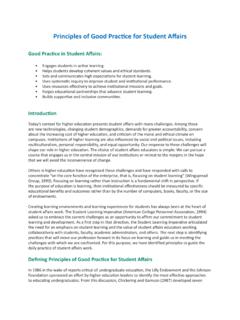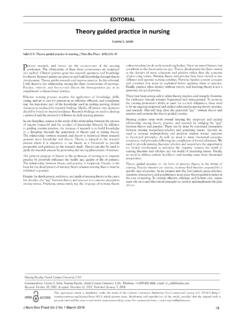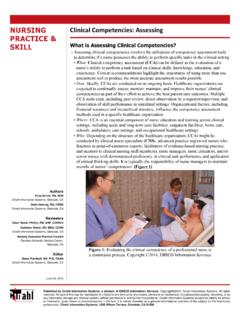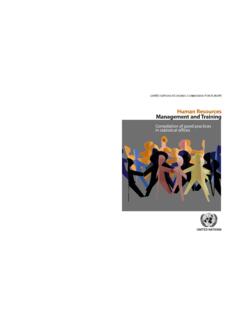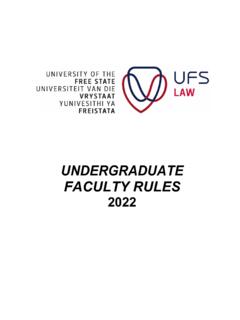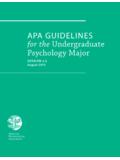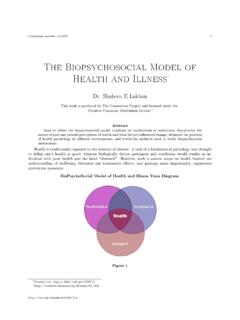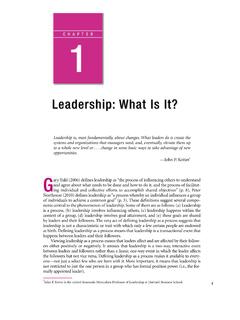Transcription of Occupational Therapy Guide to Good Practice: Working with ...
1 Occupational Therapy Guide to good Practice: Working with Children Occupational Therapy AUSTRALIA (2018) 2 About Occupational Therapy Australia Occupational Therapy Australia is the professional association for Occupational therapists in Australia. Our members are qualified Occupational therapists employed throughout the public and private sectors. They provide health care, vocational rehabilitation, and consultancy to clients. Our mission is to provide member benefits through access to local professional support and resources, and through opportunities to contribute to, and shape, professional excellence.
2 For more information about Occupational Therapy Australia, visit Occupational Therapy Australia 2016 This work is copyright. You may download, display, print and reproduce this material in unaltered form only (retaining this notice) for your personal, non-commercial use or use within your organisation. Apart from any use as permitted under the Copyright Act 1968, all other rights are reserved. Occupational Therapy Australia reviews its publications on a staged basis. The Occupational Therapy Guide to good Practice: Working with Children is due for review in May 2017. Requests for further authorisation should be directed to The National Manager: Professional Practice and Standards, care of: Occupational Therapy Australia 6/340 Gore Street Fitzroy VIC 3065 or Occupational Therapy AUSTRALIA (2018) 3 Context The Guide to good Practice for Working with Children was developed by Occupational Therapy Australia s Paediatric Taskforce over 18 months.
3 It incorporates current evidence and practice knowledge and has undergone consumer review. The primary intent of the Guide is to inform Occupational therapists about good practice principles in the absence of formalised clinical practice guidelines, and in response to Occupational Therapy Australia data on practice queries. The Guide will be reviewed in one year with a view to inclusion of other child-based practices and settings, and other aspects based on feedback. Acknowledgements Occupational Therapy Australia acknowledges the expertise and input of the following members of the Occupational Therapy Australia Paediatric Taskforce in authoring the Guide to good Practice: Nicole Brown; Nikki Chegwyn; Rachelle Coe; Elizabeth Edgar; Dr Elspeth Froude; Cate Hilly; Deb Hopper; Dr Fiona Jones; Dr Annette Joosten; Aneesa Kathrada; Erin Kelly; Emma King; Caroline Mills; Jacky Peile; Celeste Riach; Liz Springfield; Lisa Vale; and Tara Whiteford.
4 Introduction The Occupational Therapy Guide to good Practice for Working with Children provides practice guidelines for Occupational therapists who work with children (aged 0-18 years) and their families/caregivers. This can be used as a reference for Occupational therapists, consumers, and organisations. It outlines expectations for good practice. The need for a good practice Guide was identified by Occupational Therapy Australia s Paediatric Taskforce, which was established in July 2014 to advise the National Professional Practice and Standards Portfolio and the Board of Occupational Therapy Australia on issues relevant to paediatric practice.
5 The Guide was developed by the National Paediatric Steering Group of Occupational Therapy Australia with input from the National Paediatric Reference Group and a range of other key stakeholders including the Board of Occupational Therapy Australia. The Guide incorporates information from a range of sources: experienced Occupational therapists practicing in the field, researchers, academics, current evidence, and governing bodies relevant to Occupational Therapy practice and children. The information in this Guide was developed to be used by Occupational therapists who work with children and their families/caregivers to articulate what is expected of Occupational therapists who work with these individuals.
6 Particular acknowledgement is made of the 2007 UK Guide to good Practice for Paediatric Physiotherapists (Association of Paediatric Chartered Physiotherapists), which informed the framework for this document. The Guide is intended to complement other key documents including the AHPRA Code of Conduct, the Occupational Therapy Australia Code of Ethics (2001), and the Occupational Therapy Australia Competency Standards for Entry-Level Practitioners (2010). A range of other regulatory and legislative documents may apply depending on jurisdiction, service type, and employment structure. Occupational Therapy AUSTRALIA (2018) 4 Table of Contents Context.
7 3 Acknowledgements ..3 Introduction ..3 Table of Contents ..4 Section 1: Occupational Therapy as a profession ..6 What is Occupational Therapy ? ..6 Occupational Therapy with children ..6 Section 2: Occupational Therapy practice ..6 Legal and ethical frameworks ..6 Consent in Occupational Therapy ..7 What is the role of the Occupational therapist in safeguarding children? ..8 Checking staff against criminal registers ..8 Respect, privacy and confidentiality ..8 Cultural safety and responsiveness ..8 Fees ..9 Advertising ..9 Use of titles and descriptors .. 10 Continuing professional development .. 10 Section 3: Occupational Therapy practice with children.
8 11 Evidence-based practice: knowledge for practice, applying knowledge in practice, competencies and standards .. 11 Collaborative practice .. 12 Settings and contexts .. 12 Autonomy and delegation .. 12 Section 4: Providing high quality services for children and their families .. 13 What do Occupational therapists do? .. 13 Occupational Therapy process .. 13 How do Occupational therapists deliver their services?.. 14 Record keeping and documentation .. 15 Section 5: Child-related policy .. 18 Safeguarding children .. 18 Standards for disability services .. 19 Education .. 19 Section 6: Funding Schemes .. 19 Access to Allied Psychological Services (ATAPS).
9 19 Occupational Therapy AUSTRALIA (2018) 5 Better Access to Mental Health (BAMH) .. 19 Better Start for Children with Disability Initiative .. 19 Chronic Disease Management Plan .. 20 Enhanced Primary Care .. 20 Helping Children with Autism .. 20 Medicare .. 20 National Disability Insurance Scheme (NDIS) .. 20 Section 7: Useful general information .. 21 Useful terms and definitions .. 21 References .. 24 Occupational Therapy AUSTRALIA (2018) 6 SECTION 1: Occupational Therapy as a profession What is Occupational Therapy ? Occupational Therapy is a client-centred health profession concerned with promoting health and wellbeing through occupation.
10 Occupations refer to the everyday activities that people do as individuals, in families, and with communities to occupy time and bring meaning and purpose to life. Occupations include things people need to, want to, and are expected to do (World Federation of Occupational Therapists, 2011). The primary goal of Occupational Therapy is to enable people to participate in their daily occupations or activities. Occupational therapists complete a university degree at undergraduate or graduate entry Masters level that provides them with a knowledge base in Occupational Therapy theory and science, neurology, anatomy, physiology, kinesiology, lifespan including child development, sociology, psychology, psychosocial development, activity-task-environment analysis, and therapeutic techniques.




